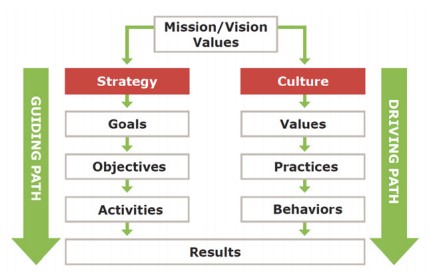Culture Eats Strategy for Breakfast?!
In the class, we discussed about the eight stages of creating change from Leading Change by John Kotter. The eight steps could be summarized in this way.
Create a climate for change:
- Establish a Sense of Urgency
- Create a guiding coalition
- Develop a vision:
Engage and Enable the Whole Organization:
- Communicate for buy-in
- Empower employees to act
- Generate short-term wins
Implement and Sustain the Change
- Consolidate gains to build momentum
- Anchor changes in the culture
During the process of creating a climate of change and sustaining it, we realized that culture is a big issue. “Culture eats strategy for breakfast”, a phrase originated by Peter Drucker, is an absolute reality! Any organizations that disconnects the two are putting their success at risk.
Sometimes culture makes work more efficient than strategy. It reminds me of a story about Google I read before: Google allows its employees the option to use up to 20% of their work week at Google to pursue special projects. So employees can take a full day to work on a project unrelated to their normal workload for every standard work week. Google claims that many of their products in Google Labs started out as pet projects in the 20% time program.
However, what about combining these two together? Strategy and culture are two inevitable elements from the article written by Rick Torben. Strategy sets down the rules for playing the game, and culture fuels the emotion for how the game will be played. “Strategy is about intent and ingenuity, and culture determines and measures desire, engagement, and execution.”
Read more on
http://www.torbenrick.eu/blog/wp-content/uploads/2013/06/LeaderMag-Aug-2013.pdf
– Jingyi


Thanks for the great blog, Jingyi! I had not heard of this approach before and I like it a lot. Great link. Very well done! -Rob
Where Kotter’s model falls short, I think, is at point 5: empower employees to act. If an organisation changes, it presumably needs to do something different. Whether this is to produce the same outputs and outcomes or different ones, there would need to be a change in delivery systems, organisational relationships, perhaps resource or supplier relationships and maybe market communications. Thus, someone (preferably those closest to the activity) need to design, pilot and implement new systems, and develop measures of performance so that system deficiencies can be spotted and corrected. Without these, there will be no practical objective change, only ‘affective’ feel-good or ends-badly change.